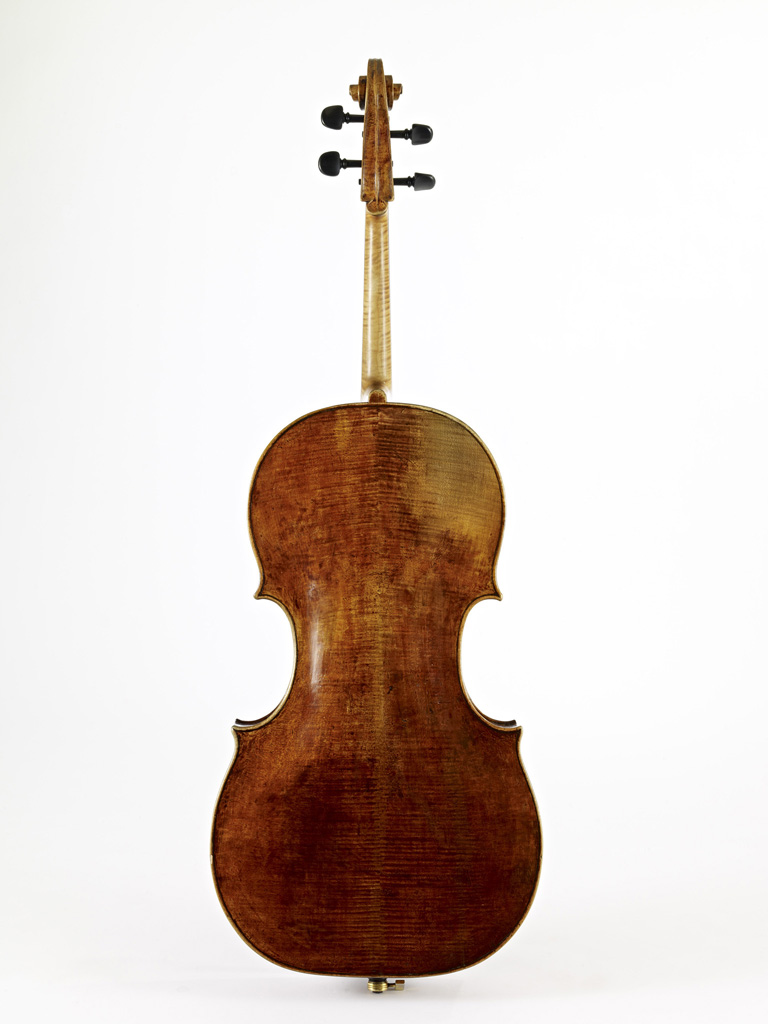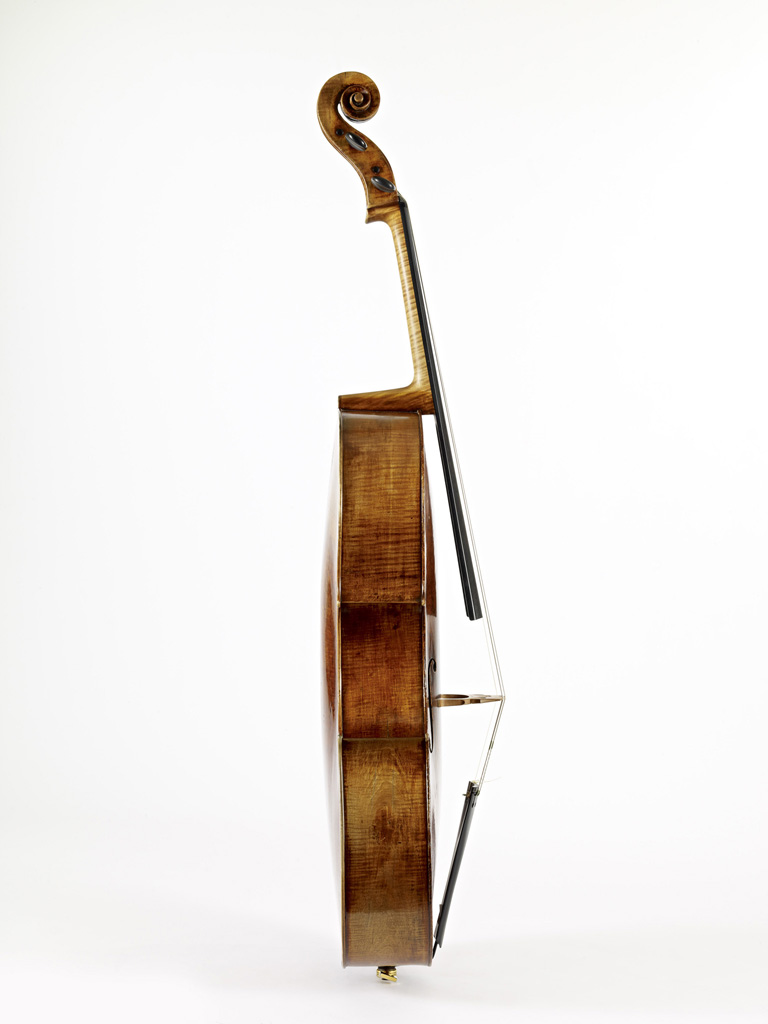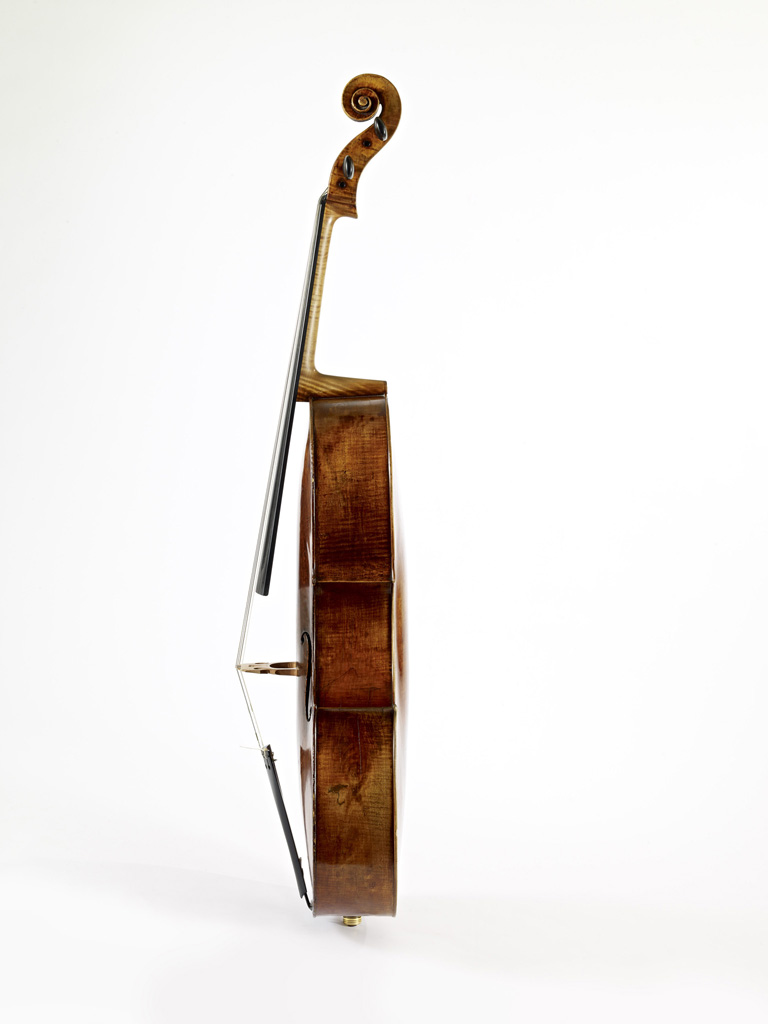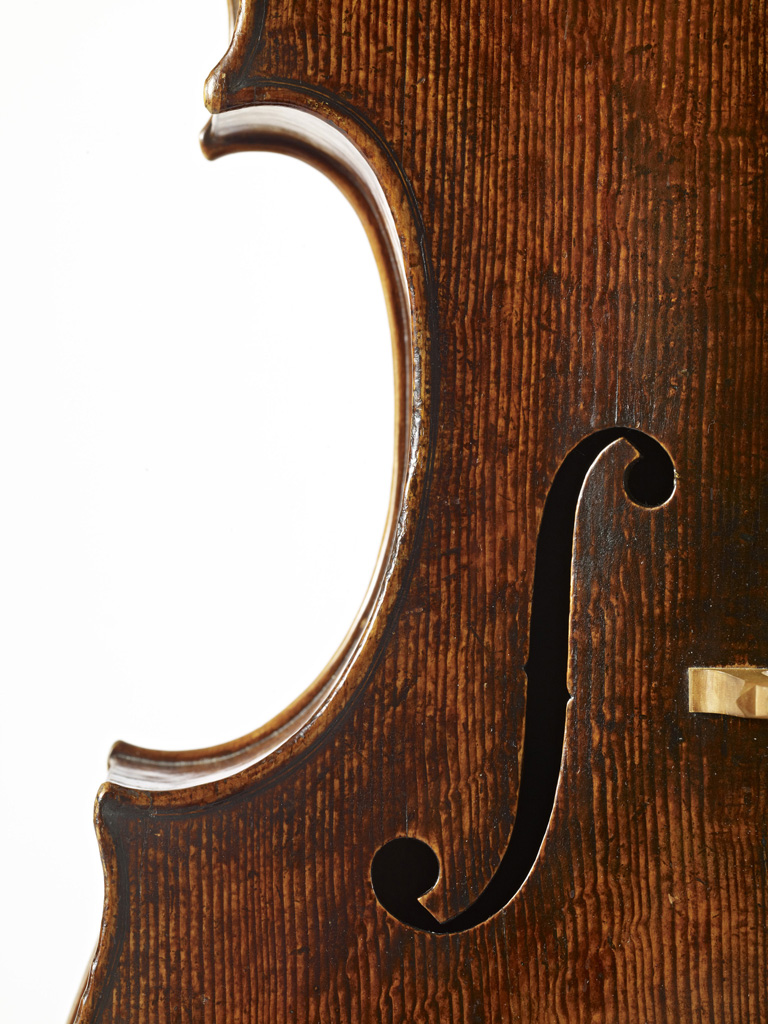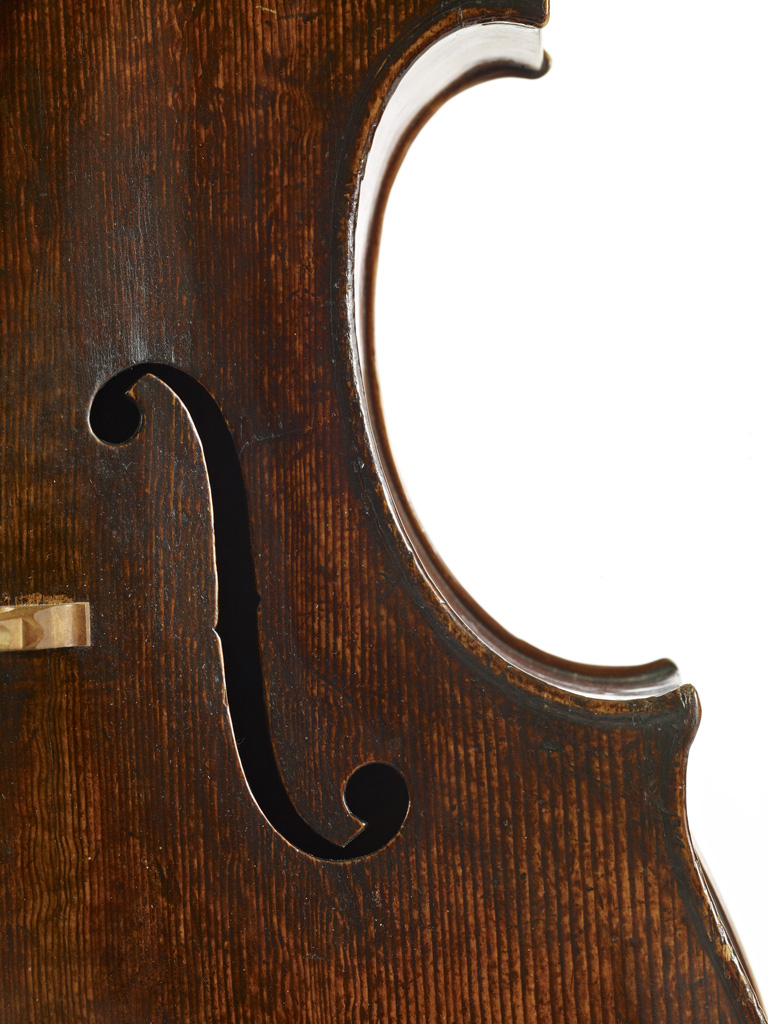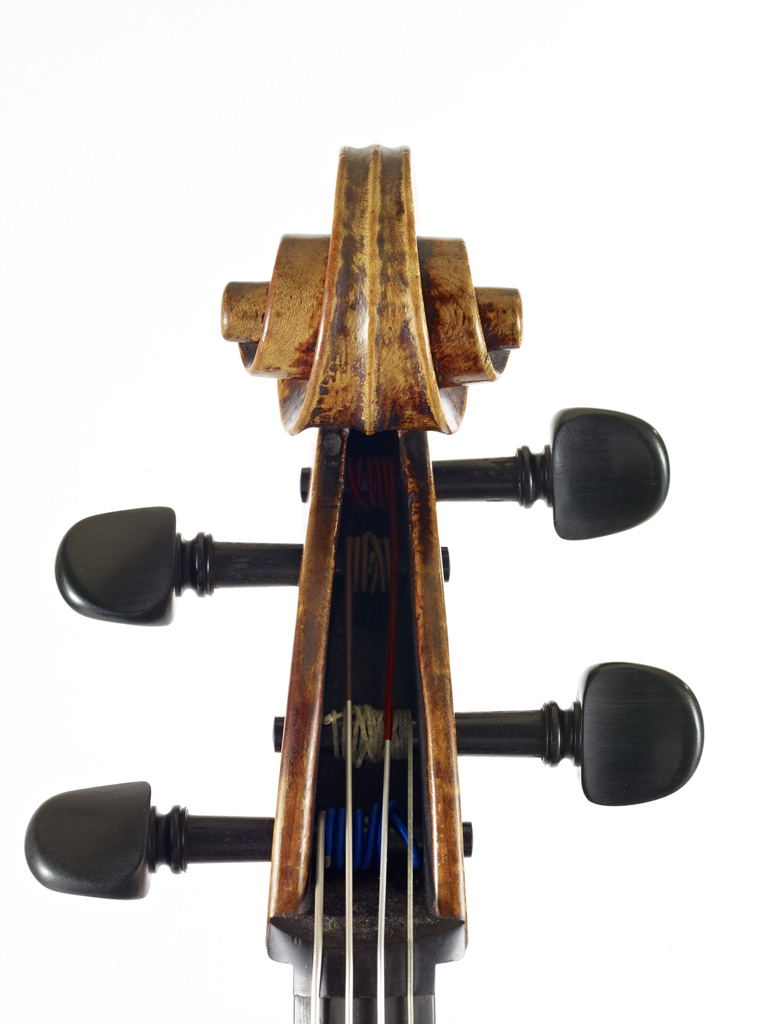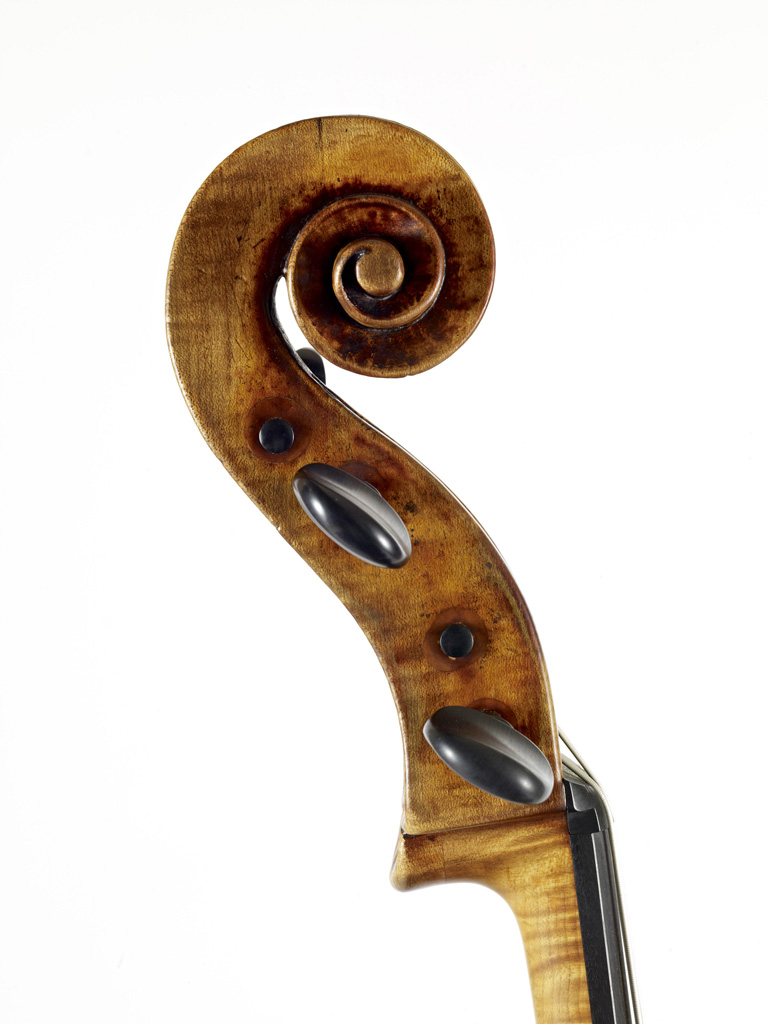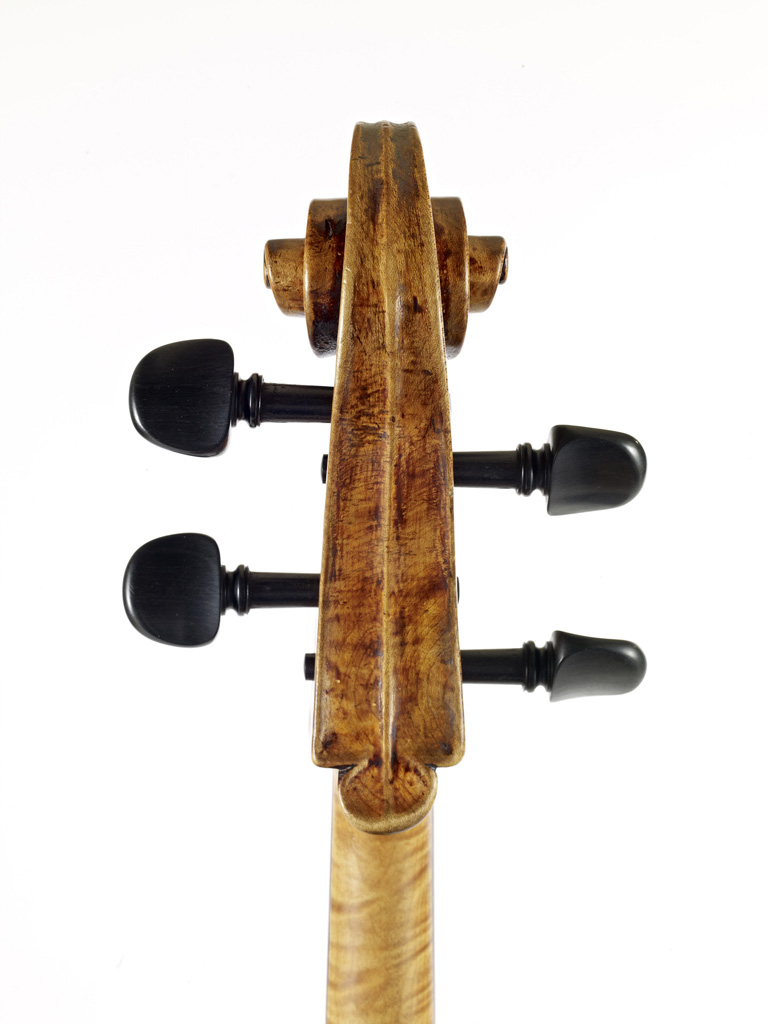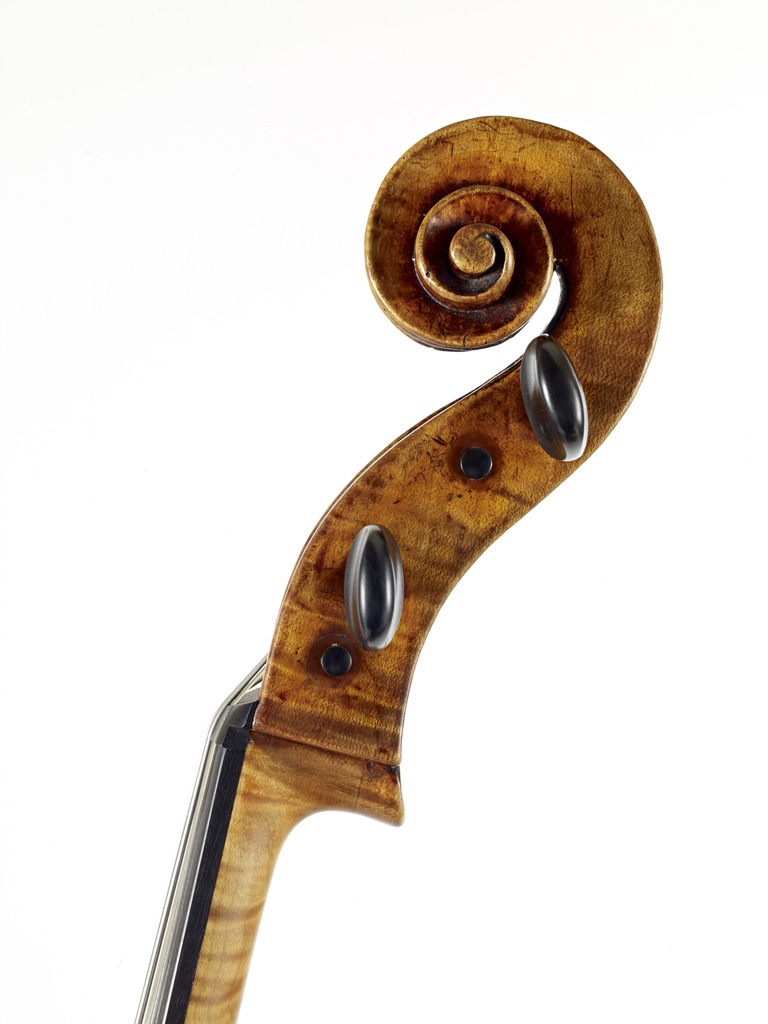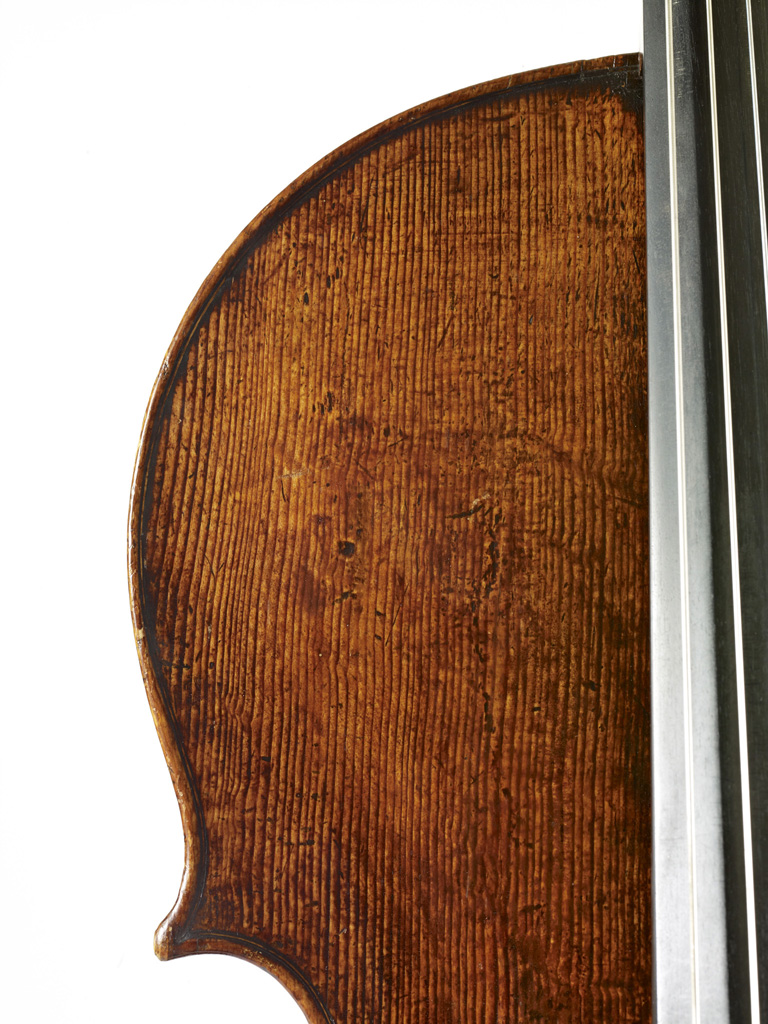Cello by Nicolò Amati, Cremona, c1680

Instrument
The table is of two matched pieces of Haselfichte with 10 to 3 growth rings per cm. The shoulders have been cut down and the upper edge replaced from about halfway along the upper bout on each side. The single purfling is black-white-black.
The back is two matched pieces of quartered maple with narrow flame sloping slightly down from the center joint. It has been cut down like the table. The purfling is the same as that of the table.
The ribs are six pieces of maple. The lower and middle bouts are slab cut with narrow flame, and the upper bouts, which would be new wood, are quartered with a broader flame.
The neck is not original. The scroll is of lightly flamed maple. Tool marks are visible in the deeply undercut volutes, and the throat is very open. The front view is slightly asymmetrical. The modern pegs are ebony.
The varnish is dark red brown.
Body length
over table 76.9
over back 77.5
Body width
upper bout 34.9
center bout 22.8
lower bout 44.9
String length 69.8
Rib height
top block 10.7
upper corners 10.9
lower corners 11.1
bottom block 11.4
Bought in August 1985 from Richard Sher, New York
Papers dated September 1964 from Étienne Vatelot, a well known dealer in Paris, state that it was previously owned by Johannes C.D. Zahn. Vatelot also wrote that it was called “La Josephine” and was owned in the 19th century by the famous cellist Hippolyte-Prosper Seligmann. Bein and Fushi also prepared papers for it at the time that we bought it.
Maker
The Amati family is nearly legendary in the world of stringed instruments for having produced four generations of excellent violin makers, who practiced their profession in Cremona from the middle of the 16th to the end of the 17th century. Andrea Amati (d. 1577), the founder of the dynasty, is often credited with having developed the design of the violin, viola, and cello as they are known today. His sons Antonio (c1540–1607) and Girolamo (c1550–1630) subsequently achieved international fame and influence, and their work was widely copied throughout Europe for more than a century after their deaths. Girolamo’s son Nicolò (1596–1684) is considered by some to have been not only the best maker in the family but also one of the finest craftsmen in the history of violin making, renowned not only for his own work but for having trained many other important makers, possibly including the most famous of all, Antonio Stradivari.
Judging from extant instruments, Nicolò Amati made mostly violins, together with a much smaller number of violas, cellos, and contrabasses: the database at www.cozio.com currently lists only a dozen cellos (including this one in the Caldwell Collection) among more than 200 instruments attributed to him. He officially took over the family business after his father died in 1630, but had probably been responsible for most of its production for up to a decade before then. Similarly, Girolamo II (1649–1740), the son of Nicolò and his wife Lucrezia Pagliari, was effectively in charge of the shop from about 1670, more than a decade before Nicolò’s death, though with diminishing output towards the end of the century, perhaps due to competition from other Cremonese makers such as Stradivari.
The story of how we acquired this instrument requires a description of Daniel Draley, the man who convinced us we must have it. He was a dealer in fine violins working out of his home in Grand Mound, Iowa. In a marvelous coincidence, my father was born (in 1906) and grew up in Grand Mound, and Daniel rented a house from a cousin of mine. As a young man he trained himself in woodworking and made wooden children’s toys. He developed an interest in violins and again trained himself by visiting violin dealers in the Chicago area and looking and looking. By the time we knew him he was making a name for himself by entering a room of instruments and naming the makers and dates within five years in each case. He did this in Oberlin with a string quartet and more famously at the Smithsonian’s collection. When he came to see our viols he admitted that he knew nothing of viols and would not be able to give us the names of the makers, but he did bet us that he could get within ten miles and ten years of each instrument, and he did. We were very impressed and we immediately formed a friendship with him based on our shared love of stringed instruments.
Several years later he was traveling though Oberlin during the Baroque Performance Institute. His sales method at that time was to pack up a station wagon with his young family and with Amatis, Strads, and other fine violins in the back. He would drive to various workshops, conferences, etc. where there might be customers. He would gather information on who was looking for an upgrade or was in the market and spend a lot of energy finding the right violin or cello for that person. He went to the auctions, knew all the major dealers, and had gained a reputation of being perhaps eccentric in his business methods but having an infallible eye. He and Charles Beare of London, possibly the most respected of stringed-instrument dealers, collaborated on examinations of instruments and Daniel started to specialize in knowledge of the Amati family. He published a beautiful catalogue of Amati instruments in 1989. Unfortunately, the ravages of Parkinson’s disease have limited his work in recent years.
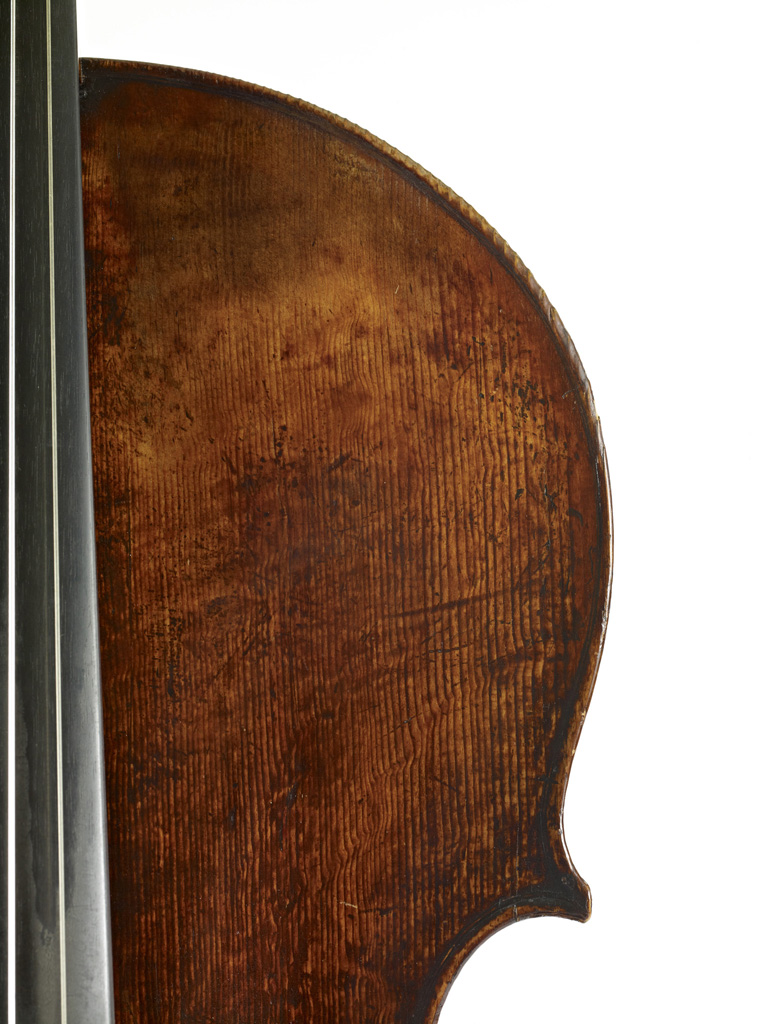
When Daniel arrived in Oberlin he had a beautiful Nicolò Amati cello with him. He showed it first to Jim, who promptly fell in love with it. Jim called me into his studio and asked me to try it. Since it was in the middle of BPI I had not touched a modern cello for weeks, but had been playing my nice baroque cello and my great Tielke viol. So my reaction was “That’s nice, it feels just like a baroque cello,” meaning that it had the easy response of a baroque instrument and I didn’t have to work to play it at all. I was not all that impressed. Jim’s reaction was to ask,“Do you realize how much sound you are putting out?” I picked up my Tielke and suddenly knew that the Amati was a powerhouse that happened to feel as easy to play as an early instrument. He also noted that I seemed to play oddly better in tune and asked other BPI cellists to try it. As he sat listening he said he heard each cellist sound like a better cellist in just a few minutes, especially in intonation. It was a curious phenomenon that must have something to do with the clarity of the overtones.
Daniel had brought the cello strung with the usual modern steel strings. I have used gut strings on modern cello since 1970 when I started playing early instruments seriously. I found it not only made switching back and forth easier, but also made my Panormo more responsive and colorful. Jim was a big influence in that change. Having worked with Pablo Casals in Puerto Rico, he knew that Casals had always played gut strings and encouraged me to change even to an open gut A. I auditioned for the Cleveland Orchestra with four gut strings and no one seemed to notice. So I knew that we wanted to hear the cello with gut strings if we were to consider it seriously. Daniel was thrilled at the idea, knowing that old instruments are safer with the lower tension of gut strings. He suggested we take it to Oberlin’s small recital hall and change one string at a time and savor the changes. From the C string up, the cello relaxed perceptibly, and by the time the A was changed we could almost hear it breathing sighs of relief. It had not become significantly softer, but rather even more responsive. Our mentor, August Wenzinger, was present for this transformation and we remember him saying, “This is a cello to love.”
It was not easy to make the decision to invest so heavily in a cello. We had already invested in a major collection of viols, a number of which had yet to be restored. We had a young son and I was limiting my non-orchestral professional activities to be a responsible parent. Jim would not be able even to play this instrument (he tested cellos using an underhand gamba grip on the bow). It seemed like a selfish act on my part to bind up our finances for years despite the fact that Jim was the one who was pushing for this. We actually went through some marriage counseling as we were pondering such a life-changing purchase. After a number of weeks with the cello, my thriftiness was winning out, and Daniel was coming to pick it up. He took me upstairs to our gamba room where the viols were hung on the wall. He wisely did not invite Jim. He then proceeded to give me the speech that I needed. He said, “You love instruments, don’t you?” That was pretty obvious by looking at the wall. He continued, “You take care of instruments, don’t you?” That was also obvious by looking at the beautiful restorations we had overseen. He then delivered the kicker: “How do you know that whoever buys this cello will take as good care of it as you would?” And he had me. He had said the one thing that made me feel it was an altruistic act to buy an Amati cello.
We started seriously working on the financing, remortgaging our house and selling a number of instruments. Deaccessioning, as the museum world terms it, is often a painful process. Some of the instruments we sold had been mine since I was a teenager. The cello I had used through high school was a nice, smallish Joseph Kloz. We were able to sell it to a student of mine who had it converted into a very successful baroque cello that she still uses. Even more wrenching was the selling of the Vincenzo Panormo cello that I had bought with my own funds while I had been a student at Eastman. I loved that cello despite the prospect of playing an Amati for the rest of my life. So I was thrilled when Jim successfully negotiated its sale to my long-time (twenty years!) stand partner in the Cleveland Orchestra, Ralph Curry. Daniel also arranged with the seller, Richard Sher of New York City, that we could pay him over several years, so we were finally able to buy the Amati. As a result, the crowning jewel of the Caldwell Collection of Viols is actually a cello.



